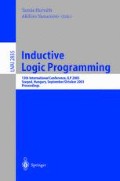Abstract
The key ingredient for any distance-based method in machine learning is a proper distance between individuals of the domain. Distances for structured data have been investigated for some time, but no general agreement has been reached. In this paper we use first-order terms for knowledge representation, and the distances introduced are metrics that are defined on the lattice structure of first-order terms. Our metrics are shown to improve on previous proposals in situations where feature equality is important. Furthermore, for one of the distances we introduce, we show that its metric space is isometrically embedable in Euclidean space. This allows the definition of kernels directly from the distance, thus enabling support vector machines and other kernel methods to be applied to structured objects. An extension of the distances to handle sets and multi-sets, and some initial work for higher-order representations, is presented as well.
Access this chapter
Tax calculation will be finalised at checkout
Purchases are for personal use only
Preview
Unable to display preview. Download preview PDF.
References
Aha, D.W. (ed.): Lazy Learning. Kluwer Academic Publishers, Dordrecht (1997)
Baier, C., Majster-Cederbaum, M.E.: Metric semantics from partial order semantics. Acta Informatica 34(9), 701–735 (1997)
Bentley, J.L.: Multidimensional binary search trees used for associative searching. Communications of the ACM 18(9), 509–517 (1975)
Emde, W., Wettschereck, D.: Relational Instance-Based Learning. In: Saitta, L. (ed.) Proceedings of the Thirteenth International Conference on Machine Learning, pp. 122–130. Morgan Kaufmann, San Francisco (1996)
Friedman, J., Bentley, J., Finkel, R.: An algorithm for finding best matches in logarithmic expected time. ACM Transactions on Mathematical Software 3(3), 209–226 (1977)
Gärtner, T., Lloyd, J.W., Flach, P.A.: Kernels for Structured Data. In: Matwin, S., Sammut, C. (eds.) ILP 2002. LNCS (LNAI), vol. 2583, pp. 66–83. Springer, Heidelberg (2003)
Greub, W.: Linear Algebra. Springer, Heidelberg (1975)
Horvath, T., Wrobel, S., Bohnebeck, U.: Relational Instance-Based Learning with Lists and Terms. Machine Learning 43(1/2), 53–80 (2001)
Hutchinson, A.: Metrics on terms and clauses. In: van Someren, M., Widmer, G. (eds.) ECML 1997. LNCS (LNAI), vol. 1224, pp. 138–145. Springer, Heidelberg (1997)
Kirsten, M., Wrobel, S.: Extending k-means clustering to first-order representations. In: Cussens, J., Frisch, A.M. (eds.) ILP 2000. LNCS (LNAI), vol. 1866, pp. 112–129. Springer, Heidelberg (2000)
Kirsten, M., Wrobel, S., Horvath, T.: Distance Based Approaches to Relational Learning and Clustering. In: Džeroski, S., Lavrač, N. (eds.) Relational Data Mining, ch. 9, pp. 213–232. Springer, Heidelberg (2001)
Lloyd, J.W.: Knowledge representation, computation and learning in higher-order logic (2001), Available at http://csl.anu.edu.au/~jwl
Lloyd, J.W.: Higher-order computational logic. In: Kakas, A.C., Sadri, F. (eds.) Computational Logic: Logic Programming and Beyond. LNCS (LNAI), vol. 2407, pp. 105–137. Springer, Heidelberg (2002)
Mavroeidis, D.: Distances and generalization structures in first-order and higher-order representations. Master’s thesis, Department of Computer Science, University of Bristol (2002)
Nienhuys-Cheng, S.H.: Distance Between Herbrand Interpretations: A Measure for Approximations to a target concept. In: Džeroski, S., Lavrač, N. (eds.) ILP 1997. LNCS (LNAI), vol. 1297, pp. 213–226. Springer, Heidelberg (1997)
Pekalska, E., Paclik, P., Duin, R.: A Generalized Kernel Approach to Dissimilarity-based Classification. Journal of Machine Learning Research 2, 175–211 (2001)
Plotkin, G.D.: A note on inductive generalization. In: Machine Intelligence, vol. 5, pp. 153–163. Edinburgh University Press (1970)
Ramon, J., Bruynooghe, M.: A framework for Defining Distances Between First-Order Logic Objects. In: Page, D.L. (ed.) ILP 1998. LNCS (LNAI), vol. 1446, pp. 271–280. Springer, Heidelberg (1998)
Author information
Authors and Affiliations
Editor information
Editors and Affiliations
Rights and permissions
Copyright information
© 2003 Springer-Verlag Berlin Heidelberg
About this paper
Cite this paper
Mavroeidis, D., Flach, P.A. (2003). Improved Distances for Structured Data. In: Horváth, T., Yamamoto, A. (eds) Inductive Logic Programming. ILP 2003. Lecture Notes in Computer Science(), vol 2835. Springer, Berlin, Heidelberg. https://doi.org/10.1007/978-3-540-39917-9_17
Download citation
DOI: https://doi.org/10.1007/978-3-540-39917-9_17
Publisher Name: Springer, Berlin, Heidelberg
Print ISBN: 978-3-540-20144-1
Online ISBN: 978-3-540-39917-9
eBook Packages: Springer Book Archive

